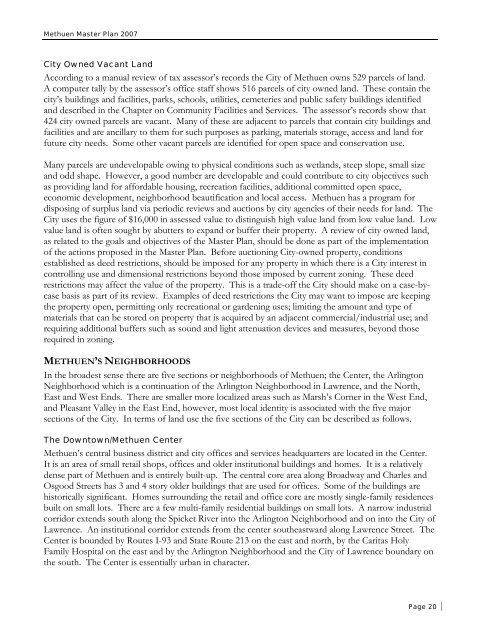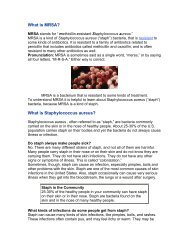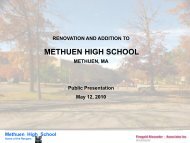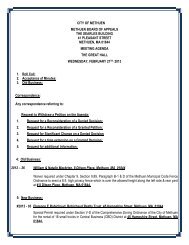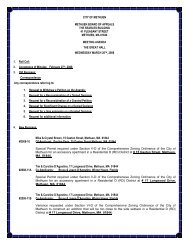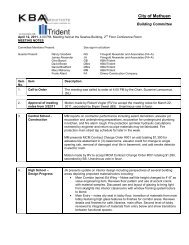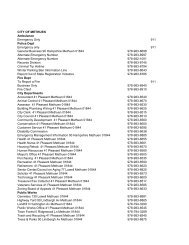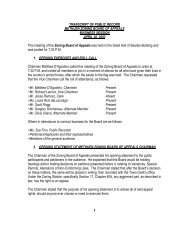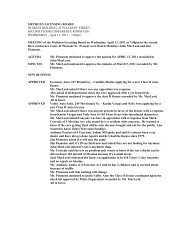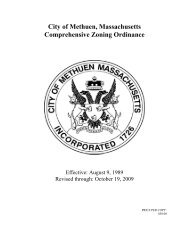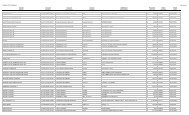City of Methuen Master Plan
City of Methuen Master Plan
City of Methuen Master Plan
You also want an ePaper? Increase the reach of your titles
YUMPU automatically turns print PDFs into web optimized ePapers that Google loves.
<strong>Methuen</strong> <strong>Master</strong> <strong>Plan</strong> 2007<br />
<strong>City</strong> Owned Vacant Land<br />
According to a manual review <strong>of</strong> tax assessor’s records the <strong>City</strong> <strong>of</strong> <strong>Methuen</strong> owns 529 parcels <strong>of</strong> land.<br />
A computer tally by the assessor’s <strong>of</strong>fice staff shows 516 parcels <strong>of</strong> city owned land. These contain the<br />
city’s buildings and facilities, parks, schools, utilities, cemeteries and public safety buildings identified<br />
and described in the Chapter on Community Facilities and Services. The assessor’s records show that<br />
424 city owned parcels are vacant. Many <strong>of</strong> these are adjacent to parcels that contain city buildings and<br />
facilities and are ancillary to them for such purposes as parking, materials storage, access and land for<br />
future city needs. Some other vacant parcels are identified for open space and conservation use.<br />
Many parcels are undevelopable owing to physical conditions such as wetlands, steep slope, small size<br />
and odd shape. However, a good number are developable and could contribute to city objectives such<br />
as providing land for affordable housing, recreation facilities, additional committed open space,<br />
economic development, neighborhood beautification and local access. <strong>Methuen</strong> has a program for<br />
disposing <strong>of</strong> surplus land via periodic reviews and auctions by city agencies <strong>of</strong> their needs for land. The<br />
<strong>City</strong> uses the figure <strong>of</strong> $16,000 in assessed value to distinguish high value land from low value land. Low<br />
value land is <strong>of</strong>ten sought by abutters to expand or buffer their property. A review <strong>of</strong> city owned land,<br />
as related to the goals and objectives <strong>of</strong> the <strong>Master</strong> <strong>Plan</strong>, should be done as part <strong>of</strong> the implementation<br />
<strong>of</strong> the actions proposed in the <strong>Master</strong> <strong>Plan</strong>. Before auctioning <strong>City</strong>-owned property, conditions<br />
established as deed restrictions, should be imposed for any property in which there is a <strong>City</strong> interest in<br />
controlling use and dimensional restrictions beyond those imposed by current zoning. These deed<br />
restrictions may affect the value <strong>of</strong> the property. This is a trade-<strong>of</strong>f the <strong>City</strong> should make on a case-bycase<br />
basis as part <strong>of</strong> its review. Examples <strong>of</strong> deed restrictions the <strong>City</strong> may want to impose are keeping<br />
the property open, permitting only recreational or gardening uses; limiting the amount and type <strong>of</strong><br />
materials that can be stored on property that is acquired by an adjacent commercial/industrial use; and<br />
requiring additional buffers such as sound and light attenuation devices and measures, beyond those<br />
required in zoning.<br />
METHUEN’S NEIGHBORHOODS<br />
In the broadest sense there are five sections or neighborhoods <strong>of</strong> <strong>Methuen</strong>; the Center, the Arlington<br />
Neighborhood which is a continuation <strong>of</strong> the Arlington Neighborhood in Lawrence, and the North,<br />
East and West Ends. There are smaller more localized areas such as Marsh’s Corner in the West End,<br />
and Pleasant Valley in the East End, however, most local identity is associated with the five major<br />
sections <strong>of</strong> the <strong>City</strong>. In terms <strong>of</strong> land use the five sections <strong>of</strong> the <strong>City</strong> can be described as follows.<br />
The Downtown/<strong>Methuen</strong> Center<br />
<strong>Methuen</strong>’s central business district and city <strong>of</strong>fices and services headquarters are located in the Center.<br />
It is an area <strong>of</strong> small retail shops, <strong>of</strong>fices and older institutional buildings and homes. It is a relatively<br />
dense part <strong>of</strong> <strong>Methuen</strong> and is entirely built-up. The central core area along Broadway and Charles and<br />
Osgood Streets has 3 and 4 story older buildings that are used for <strong>of</strong>fices. Some <strong>of</strong> the buildings are<br />
historically significant. Homes surrounding the retail and <strong>of</strong>fice core are mostly single-family residences<br />
built on small lots. There are a few multi-family residential buildings on small lots. A narrow industrial<br />
corridor extends south along the Spicket River into the Arlington Neighborhood and on into the <strong>City</strong> <strong>of</strong><br />
Lawrence. An institutional corridor extends from the center southeastward along Lawrence Street. The<br />
Center is bounded by Routes I-93 and State Route 213 on the east and north, by the Caritas Holy<br />
Family Hospital on the east and by the Arlington Neighborhood and the <strong>City</strong> <strong>of</strong> Lawrence boundary on<br />
the south. The Center is essentially urban in character.<br />
Page 20


